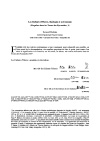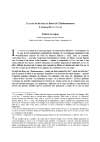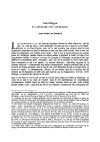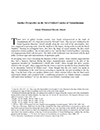Orion
« Les Enfants d’Horus, thĂ©ologie et astronomie »
ENiM 1, 2008, p. 7-14.
 Une enquête menée sur les Enfants d'Horus (Hâpy, Douamoutef, Imséti et Qébehsénouf ) dans les Textes des Pyramides permet de mettre en relief leur véritable identité théologique, leurs fonctions essentielles, ainsi que les correspondants que les Égyptiens leur avaient attribués dans le ciel nocturne, au sein des constellations que nous nommons Orion et la Grande Ourse.
Une enquête menée sur les Enfants d'Horus (Hâpy, Douamoutef, Imséti et Qébehsénouf ) dans les Textes des Pyramides permet de mettre en relief leur véritable identité théologique, leurs fonctions essentielles, ainsi que les correspondants que les Égyptiens leur avaient attribués dans le ciel nocturne, au sein des constellations que nous nommons Orion et la Grande Ourse.
 A synthetic study of the Sons of Horus (Hâpy, Duamutef, Imseti and Qebehsenuf) in the Pyramid Texts is proposed, showing their genuine theological nature, their main functions, and the celestial correspondants the Egyptian gave them in the night sky, inside the constellations we call Orion and Great Bear (Ursa Major).
A synthetic study of the Sons of Horus (Hâpy, Duamutef, Imseti and Qebehsenuf) in the Pyramid Texts is proposed, showing their genuine theological nature, their main functions, and the celestial correspondants the Egyptian gave them in the night sky, inside the constellations we call Orion and Great Bear (Ursa Major).
 Consulter cet article (68706) -
Consulter cet article (68706) -  Télécharger cet article au format pdf (36311)
Télécharger cet article au format pdf (36311)
« Le cycle du ba dans le Rituel de l’Embaumement P. Boulaq III, 8, 12-8, 16 »
ENiM 2, 2009, p. 9-23.
 L’analyse de quelques passages du Rituel de l’Embaumement (P. Boulaq III) permet de reconstituer le cycle du ba dans un contexte spécifique de momification et de comprendre la logique des traditions sur lesquelles il se fonde, résultant de l’observation minutieuse de la nature.
L’analyse de quelques passages du Rituel de l’Embaumement (P. Boulaq III) permet de reconstituer le cycle du ba dans un contexte spécifique de momification et de comprendre la logique des traditions sur lesquelles il se fonde, résultant de l’observation minutieuse de la nature.
 The analysis of some passages of the Embalming Ritual (P. Boulaq III) allows to reconstitute the cycle of the ba in a specific context of mummification and to understand the logic of the traditions on which it is based, resulting from the meticulous observation of the nature.
The analysis of some passages of the Embalming Ritual (P. Boulaq III) allows to reconstitute the cycle of the ba in a specific context of mummification and to understand the logic of the traditions on which it is based, resulting from the meticulous observation of the nature.
 Consulter cet article (90700) -
Consulter cet article (90700) -  Télécharger cet article au format pdf (37263)
Télécharger cet article au format pdf (37263)
« Ciels d’Égypte. Le « ciel du sud » et le « ciel du nord » »
ENiM 5, 2012, p. 73-102.
 Depuis les temps anciens jusqu’aux périodes tardives, les Anciens Égyptiens, pour décrire le ciel, distinguaient le « ciel du sud » et le « ciel du nord », aussi bien dans les textes que dans l’iconographie. Les représentations de la voûte céleste qui apparaissent sur des plafonds ou des couvercles de sarcophages permettent d’identifier les astres principaux du ciel dit « méridional » comme étant ceux qui se déplacent sur l’écliptique avec, essentiellement, les étoiles-décans qui balisent le parcours quotidien et annuel du soleil. Le ciel « septentrional », quant à lui, est le domaine des constellations boréales, visibles toute l’année et, pour cette raison, dénommées par les Égyptiens « Celles qui ne connaissent pas la destruction ». L’opposition « spatiale » s’accompagne d’une opposition « mythologique » : les constellations du ciel du nord sont liées à l’idée d’immortalité car on ne les voyait jamais disparaître dans la Douat. À l’inverse, les ensembles stellaires situés plus au sud, dont les prototypes sont Sirius et Orion, qui sont absents du ciel un certain temps au cours de l’année, sont comparés aux vivants : ils « vivent » lorsqu’ils brillent au firmament, et « meurent » lors de leur invisibilité, qui est ressentie comme un séjour dans la Douat. Ces observations expliquent de nombreuses allusions retrouvées dans les Textes de Pyramides.
Depuis les temps anciens jusqu’aux périodes tardives, les Anciens Égyptiens, pour décrire le ciel, distinguaient le « ciel du sud » et le « ciel du nord », aussi bien dans les textes que dans l’iconographie. Les représentations de la voûte céleste qui apparaissent sur des plafonds ou des couvercles de sarcophages permettent d’identifier les astres principaux du ciel dit « méridional » comme étant ceux qui se déplacent sur l’écliptique avec, essentiellement, les étoiles-décans qui balisent le parcours quotidien et annuel du soleil. Le ciel « septentrional », quant à lui, est le domaine des constellations boréales, visibles toute l’année et, pour cette raison, dénommées par les Égyptiens « Celles qui ne connaissent pas la destruction ». L’opposition « spatiale » s’accompagne d’une opposition « mythologique » : les constellations du ciel du nord sont liées à l’idée d’immortalité car on ne les voyait jamais disparaître dans la Douat. À l’inverse, les ensembles stellaires situés plus au sud, dont les prototypes sont Sirius et Orion, qui sont absents du ciel un certain temps au cours de l’année, sont comparés aux vivants : ils « vivent » lorsqu’ils brillent au firmament, et « meurent » lors de leur invisibilité, qui est ressentie comme un séjour dans la Douat. Ces observations expliquent de nombreuses allusions retrouvées dans les Textes de Pyramides.
 From very early times down to the late periods, the Ancient Egyptians describing the firmament distinguished the “southern sky” and the “northern sky” in their texts as well as in their iconography. Representations of the sky that appear on ceilings or coffin lids permit to identify the main stars in the sky called “southern” as those that move along the ecliptic comprising, in essence, the decanal stars that mark the daily and annual course of the sun. The northern sky, on the other hand, is the domain of the boreal constellations that are visible throughout the year, which is why the Egyptians called them “Those who do not know destruction”.The “spatial” opposition is accompanied by a “mythological” one: the constellations of the northern sky are tied to the notion of immortality because they can never be seen to vanish into the Duat. Inversely, the constellations situated further to the south, with Sirius and Orion as prototypes, which are absent from the sky during a certain lapse of time in the year, are compared to the living: they “live” while they sparkle in the night firmament and “die” during their invisibility, which is perceived as a passage in the Duat. These observations explain a great variety of mythological allusions issuing from the Pyramid Texts.
From very early times down to the late periods, the Ancient Egyptians describing the firmament distinguished the “southern sky” and the “northern sky” in their texts as well as in their iconography. Representations of the sky that appear on ceilings or coffin lids permit to identify the main stars in the sky called “southern” as those that move along the ecliptic comprising, in essence, the decanal stars that mark the daily and annual course of the sun. The northern sky, on the other hand, is the domain of the boreal constellations that are visible throughout the year, which is why the Egyptians called them “Those who do not know destruction”.The “spatial” opposition is accompanied by a “mythological” one: the constellations of the northern sky are tied to the notion of immortality because they can never be seen to vanish into the Duat. Inversely, the constellations situated further to the south, with Sirius and Orion as prototypes, which are absent from the sky during a certain lapse of time in the year, are compared to the living: they “live” while they sparkle in the night firmament and “die” during their invisibility, which is perceived as a passage in the Duat. These observations explain a great variety of mythological allusions issuing from the Pyramid Texts.
 Consulter cet article (54502) -
Consulter cet article (54502) -  Télécharger cet article au format pdf (28933)
Télécharger cet article au format pdf (28933)
« Another Perspective on the Set of Gilded Couches of Tutankhamun »
ENiM 15, 2022, p. 217-232.
 L’ensemble des lits dorés découverts dans la tombe de Toutânkhamon est examiné afin de réinterpréter leur rôle et leur identification. Cette étude combine l’iconographie de la seconde chapelle dorée de Toutânkhamon et de sa chambre funéraire, les scènes des livres du monde souterrain et l’observation détaillée des lits eux-mêmes dans les laboratoires de restauration du Grand Musée égyptien. Cela a permis d’identifier la signification et la relation entre toutes ces scènes et les lits, ainsi que leur emplacement respectif dans la tombe elle-même. Les lits participent au voyage de l’âme du défunt dans l’ascension céleste.
L'ensemble comprend trois lits représentant chacun une lionne identifiée comme une représentation de l’étoile Orion (sAH), une vache comme l’étoile Sothis (Spdt), et un hippopotame femelle hybride identifié comme une constellation du ciel boréal. Ils sont associés respectivement à la renaissance d’Osiris et de Rê dans les mythes égyptiens, à partir du stade de l’union du kA et du bA, du bA séparé, et du Ax.
L’ensemble des lits dorés découverts dans la tombe de Toutânkhamon est examiné afin de réinterpréter leur rôle et leur identification. Cette étude combine l’iconographie de la seconde chapelle dorée de Toutânkhamon et de sa chambre funéraire, les scènes des livres du monde souterrain et l’observation détaillée des lits eux-mêmes dans les laboratoires de restauration du Grand Musée égyptien. Cela a permis d’identifier la signification et la relation entre toutes ces scènes et les lits, ainsi que leur emplacement respectif dans la tombe elle-même. Les lits participent au voyage de l’âme du défunt dans l’ascension céleste.
L'ensemble comprend trois lits représentant chacun une lionne identifiée comme une représentation de l’étoile Orion (sAH), une vache comme l’étoile Sothis (Spdt), et un hippopotame femelle hybride identifié comme une constellation du ciel boréal. Ils sont associés respectivement à la renaissance d’Osiris et de Rê dans les mythes égyptiens, à partir du stade de l’union du kA et du bA, du bA séparé, et du Ax.
 The set of gilded couches discovered in the tomb of Tutankhamun is examined to interpret their role and identification anew. This study combines the iconography of the Second gilded shrine of Tutankhamun and his burial chamber, scenes from the books of the netherworld dating throughout Egyptian history, and detailed observation of the couches themselves in the restoration laboratories of the Grand Egyptian Museum. This resulted in identifying the meaning and relationship among all these scenes and the couches, as well as their respective placement in the tomb itself. The couches participate in this narrative by representing the journey of the deceased’s soul in the heavenly ascension.
The set comprises three couches representing a lioness identified as a representation of the star Orion (sAH), a cow as the star Sothis (Spdt), and a hybrid female hippopotamus identified as a constellation in the northern sky. They are associated with the rebirth of Osiris and Ra in the Egyptian myths, from the stage of the union of the kA and the bA, the bA separated, and the Ax, respectively.
The set of gilded couches discovered in the tomb of Tutankhamun is examined to interpret their role and identification anew. This study combines the iconography of the Second gilded shrine of Tutankhamun and his burial chamber, scenes from the books of the netherworld dating throughout Egyptian history, and detailed observation of the couches themselves in the restoration laboratories of the Grand Egyptian Museum. This resulted in identifying the meaning and relationship among all these scenes and the couches, as well as their respective placement in the tomb itself. The couches participate in this narrative by representing the journey of the deceased’s soul in the heavenly ascension.
The set comprises three couches representing a lioness identified as a representation of the star Orion (sAH), a cow as the star Sothis (Spdt), and a hybrid female hippopotamus identified as a constellation in the northern sky. They are associated with the rebirth of Osiris and Ra in the Egyptian myths, from the stage of the union of the kA and the bA, the bA separated, and the Ax, respectively.
 Consulter cet article (36088) -
Consulter cet article (36088) -  Télécharger cet article au format pdf (16873)
Télécharger cet article au format pdf (16873)
ENiM 18 - 2025
8 article(s) - 8 octobre 2025.
ENiM 1 à 18 (2008-2025) : 227 articles
5 226 812 téléchargements
10 441 569 consulations.
Index des auteurs

Mots clés

Derniers articles : 
CENiM - Mise en ligne des volumes Ă©puisĂ©s : 
 Anne-Sophie von BOMHARD DĂ©cans Ă©gyptiens, CENiM 23, Montpellier, 2020 — (2020)
Anne-Sophie von BOMHARD DĂ©cans Ă©gyptiens, CENiM 23, Montpellier, 2020 — (2020) 
 Jean-Claude Grenier L'Osiris ANTINOOS, CENiM 1, Montpellier, 2008 — (26 dĂ©cembre 2008)
Jean-Claude Grenier L'Osiris ANTINOOS, CENiM 1, Montpellier, 2008 — (26 dĂ©cembre 2008) 
TDENiM - Mise en ligne des volumes Ă©puisĂ©s : 
 Twitter
Twitter 4175661 visites - 3350 visite(s) aujourd’hui - 221 connecté(s)
© ENiM - Une revue d’égyptologie sur internet
Équipe Égypte Nilotique et Méditerranéenne - UMR 5140 - « Archéologie des Sociétés Méditerranéennes » (Cnrs) - Université Paul Valéry - Montpellier III

























 Contact
Contact
 Abonnez-vous !
Abonnez-vous ! Équipe Égypte Nilotique et Méditerranéenne
Équipe Égypte Nilotique et Méditerranéenne UMR 5140 « Archéologie des Sociétés Méditerranéennes » (Cnrs)
UMR 5140 « Archéologie des Sociétés Méditerranéennes » (Cnrs) Université Paul Valéry - Montpellier III
Université Paul Valéry - Montpellier III